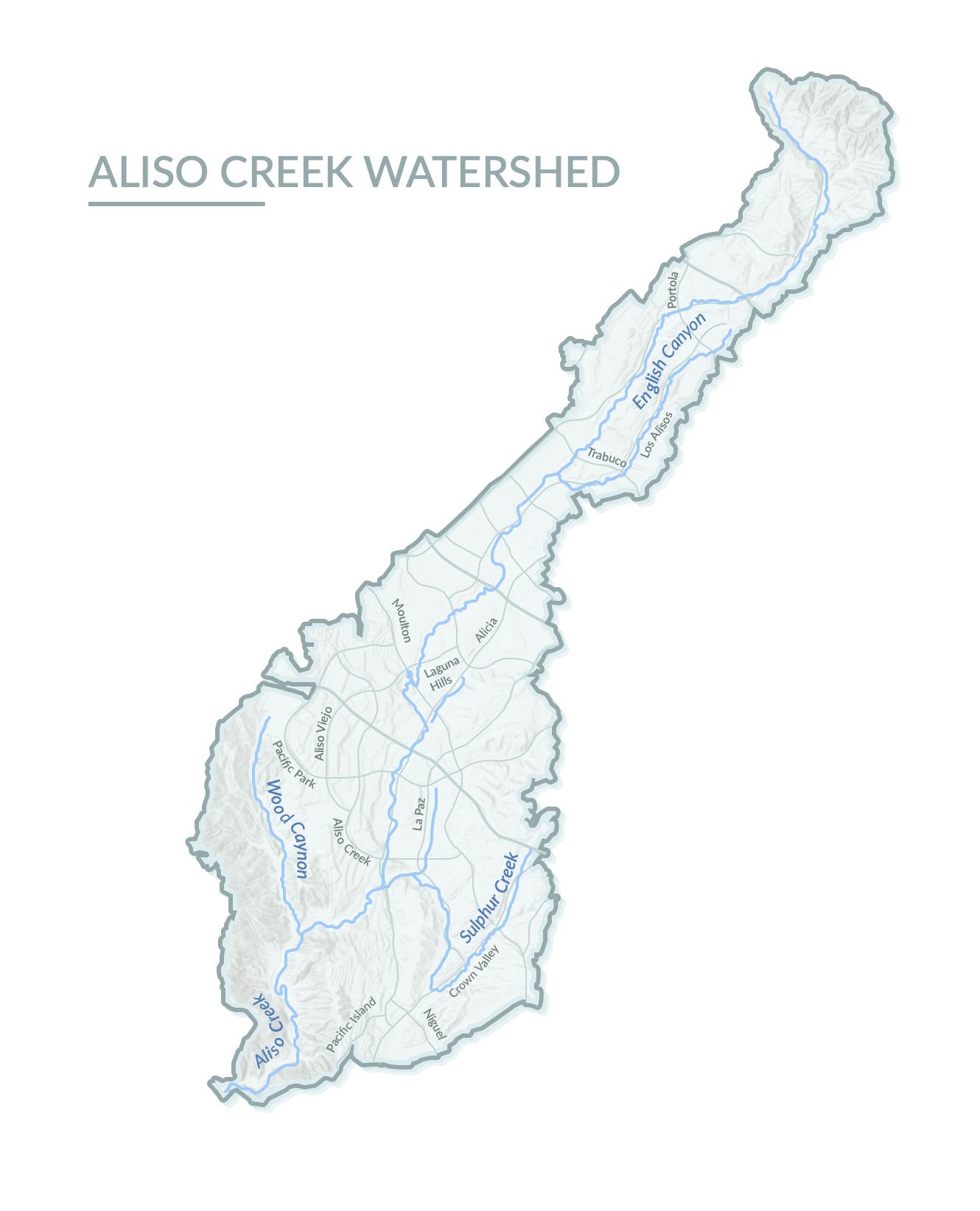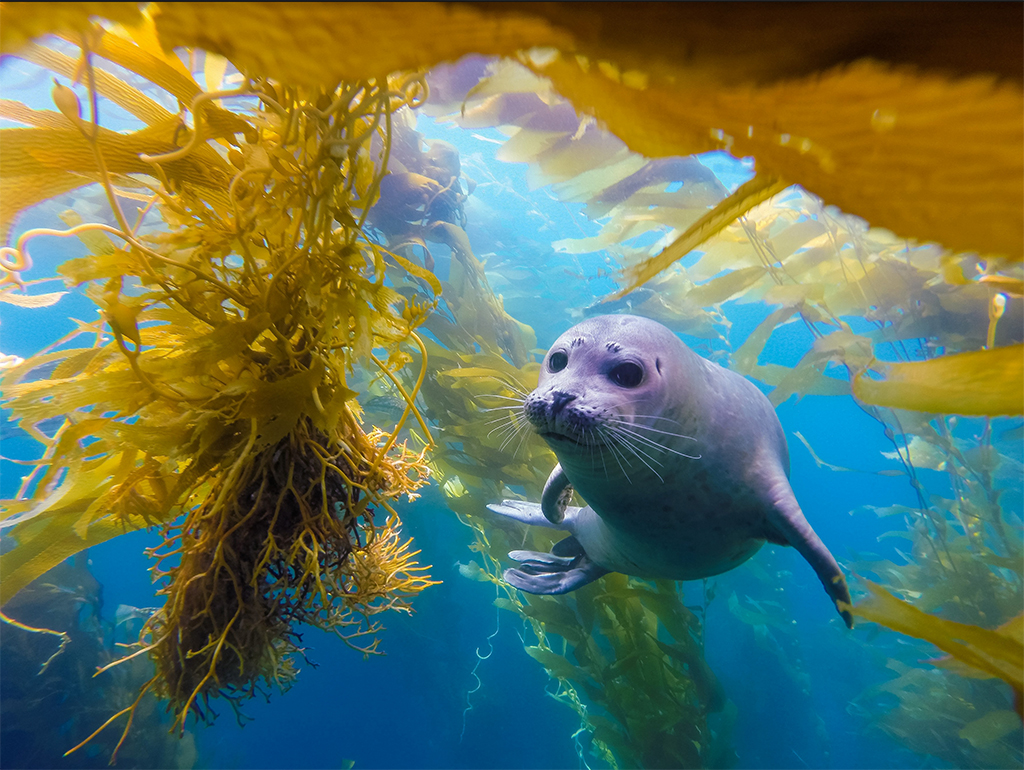Watershed Appreciation – Get To Know The Aliso Creek Watershed
March 31, 2021

Whenever you hike the trails of Aliso and Wood Canyons Wilderness Park, or swim at Aliso Beach, you are using the Aliso Creek Watershed’s resources. When in this watershed, actions you take can help improve the water quality in Orange County’s rivers, lakes, and ocean. From unique features and recreational areas, to pollution prevention, it’s time to take a deep dive and get to know the Aliso Creek Watershed.
The Aliso Creek Watershed is the first in a series of blogs that will showcase the wonders of each of the 11 watersheds in Orange County. If you’re new to the concept of watershed appreciation, our What is A Watershed? page is a great place to get started! To find out which watershed you live in, visit our interactive map.
Watersheds provide many benefits to the Orange County community. Because of this, we need to be mindful of the watershed level effects our actions can have on the environment. For instance, water from rain or outdoor water use which runs off your property picks up pollutants as it flows into storm drains that lead to waterways within your watershed. Individually, this may not seem like a lot. But when you consider the cumulative effects of runoff from everyone’s property in the watershed, the amount of polluted water in the storm drain system can be substantial. Runoff is a problem for our watersheds because it is not treated before being released into our waterways.
Aliso Creek Watershed
Unique Features
The namesake of the watershed, Aliso Creek is a natural creek that starts by Silverado Canyon Road and winds around El Toro Road. The creek flows through the watershed and outlets to the ocean at Aliso Beach. The Aliso Creek Watershed encompasses 23,000 acres of open space, rural and urban development, agriculture, ranching, regional parks, and recreational facilities. Since watersheds are determined by natural contours of the land, not city boundaries, the Aliso Creek Watershed spans seven cities – Aliso Viejo, Laguna Beach, Laguna Hills, Laguna Niguel, Laguna Woods, Lake Forest, and Mission Viejo.
The scenic trails, creeks, and beaches across the Aliso Creek Watershed are perfect places for hiking, biking, paddling, fishing, watching wildlife, and generally enjoying your day. The Aliso Creek Watershed also supports natural habitat communities for threatened and endangered species, enhancing a variety of recreational activities. Let’s take a closer look!
Wildlife & Plants
Aliso Canyon is home to a diversity of wildlife with more than 50 species of birds alone in this small coastal canyon. Large mammals still reside (and are protected) throughout the valleys and along the waterways. Large predators include bobcats, mountain lions, and coyotes. Visitors can see ducks, herons, and egrets in the creek shallows and wetlands. The Coastal Sage Scrub, found in the hills above Aliso Creek is the preferred habitat of the endangered California Gnatcatcher and Least Bell’s Vireo. Since unhealthy watersheds can make traditional habitats inhospitable to wildlife, this makes keeping the Aliso Creek Watershed clean especially important. Pollution not only harms wildlife directly, it also hurts the habitats they live in. By making the right decisions, we can all help reduce the number of pollutants that travel within the Aliso Creek Watershed!

Photo credit: Laguna Bluebelt, Alex Codwell, “Henry The Harbor Seal”
Recreational Areas
Orange County provides countless opportunities to get outside and active, have adventures, and challenge yourself. At the same time, it’s also a great place to simply sit back and enjoy the scenery. If you appreciate spending time outdoors and enjoying all that Orange County offers, then the quality of the environment around the Aliso Creek Watershed affects your quality of life more than you might think. Here’s a closer look at how.
In addition to key habitats, the Aliso Creek Watershed supports a variety of recreational activities, including hiking, biking, diving, surfing, swimming, and many other activities. Here are a few of the many recreational areas supported by the Aliso Creek Watershed.
- Aliso and Wood Canyons Wilderness Park has over 30 miles of trails for hikers, bikers, and horseback riders with scenic overlooks of the park and ocean sprawled out over approximately 4,500 acres of natural and open space. Amenities include a visitor’s center with exhibits, a parking area, picnic tables, horse watering trough, informational kiosks, and portable restrooms.
- Aliso Beach Park is open for swimming, surfing, tidepool exploration, and other beach related activities. Accessible from the Pacific Coast Highway, amenities include fire pits, a playground, food concessions, restrooms, and showers.
- Aliso Creek Regional Bikeway, Riding, and Hiking Trail, known as the “Mountains to Sea” Trail, connects Wilderness Park to Whiting Ranch Wilderness in the Cleveland National Forest. As its name strongly suggests, it is a popular destination for hiking, biking, and riding.
At H2OC, we encourage everyone to have fun exploring the many recreational areas supported by the Aliso Creek Watershed. Just remember that watersheds affect the quality of our surface water resources, so keeping our watersheds healthy is vital to keeping our waterways healthy. In the case of the Aliso Creek Watershed, if too much fecal bacteria, toxic materials, pesticides, and other pollutants get in the water, it can lead to beach closures, harm wildlife, and damage plant life.
Here’s another way to look at it. If you love hiking, just remember that healthy waterways translate to healthy hikes! Because much like the quality of our environment affects our quality of life, we can all do our part to protect our watersheds! By making the right decisions, we can all help reduce the number of pollutants that travel to the Aliso Creek Watershed (among Orange County’s other watersheds) before winding up in our creeks, rivers, lakes, and ocean.

Photo credit: Laguna Bluebelt, Scott Brashier, An Ocean Connection Begins
Water Quality
Water Quality is monitored in the Aliso Creek Watershed to be in compliance with a Municipal Separate Storm Sewer System (or MS4) Permit issued by the San Diego Regional Water Quality Control Board. The South Orange County Watershed Management Area has committed to achieving several water quality objectives in their Water Quality Improvement Plan, and monitoring data informed priorities for the Aliso Creek Watershed (click here to learn more). For example, indicator bacteria, a corollary for human and animal waste, has been identified as a priority pollutant in the Aliso Creek Watershed based on monitoring data going back almost two decades.
Since 2003, significant reductions in the levels of bacteria have occurred as a result of actions taken by local municipalities and the public. Most notably, in portions of the watershed where structural best management practices and other source control measures have been implemented have shown reductions in Fecal Coliform loading by up to 98%.
Protecting Our Aliso Creek Watershed
As Orange County residents, it is up to us to keep our watersheds clean. Although we have made a lot of progress protecting the Aliso Creek Watershed, there is still more to be done. Since reducing Fecal Indicator Bacteria is a high priority in the Aliso Creek Watershed, preventing pollution from pet waste and other human sources is paramount. Also of primary concern for the Aliso Creek Watershed are toxics, such as household hazardous waste, as well as pesticides. You can help protect the Aliso Creek Watershed by taking these simple actions to prevent pollution.
Every individual action can add up to big changes! Ready to learn how you can help? Here are some simple ways to protect Orange County’s water by protecting the Aliso Creek Watershed.
Help Reduce Indicator Bacteria (found in waste and sewage)
- Pick up pet waste in your yard at least once a week especially before a forecasted rain event.
- While walking your pet, carry bags and pick up and dispose of pet waste in a covered bin.
- Properly maintain your sewer laterals.
- Report sewage spills immediately to your sewer agency. Alternatively, you can contact the 24-Hour Pollution Prevention & Reporting Hotline by calling (877) 89-SPILL (77455) or visiting myOCeServices.ocgov.com. A quick way to find the reporting options is to click the “Report Pollution button” at the top and bottom of every page on h2oc.org.
Properly Dispose of Toxics (like Household Hazardous Waste)
- Motor oil, batteries, and paint are all examples of common household hazardous waste, and they should be taken to a Household Hazardous Waste Collection Center (HHWCC) for proper disposal.
- To find a Household Hazardous Waste Collection Center location near you, click here or call (714) 834-6752.
- To see many different items that qualify as Hazardous waste, look at this flyer.
Minimize the Use of Pesticides
- Refrain from using pesticides whenever possible.
- Instead explore safer ways to control pest populations by using non-pesticide techniques, such as Integrated Pest Management (IPM). IPM includes the use of beneficial insects, trapping (such as bait stations), weeding, and other techniques to control pests.
- If you must apply pesticides, be sure to do so when conditions are dry with minimal wind. Do not apply within 48 hours of forecasted rain.
- Follow the manufacturer’s instructions when applying pesticides and use the least amount of product possible.
The Final Takeaway?
The Aliso Creek Watershed is a wonderful resource that we need to protect. If we protect our watersheds, they will protect us. We thank you for reading this blog to better understand how pollution can contaminate our local watersheds and what you can do to help!
More Ways To Appreciate Orange County’s Watersheds
There are many ways to get involved in your community and appreciate your local watershed!
- Explore your watershed and report water pollution. Explore Orange County’s creeks, trails, and coastline and make observations about water quality conditions. If you see anything abnormal (such as dead fish, oil spills, leaking barrels, or other signs of pollution), visit our Report Pollution page to report the problem.
- Connect with area watershed organizations through local events. Join H2OC, other organizations, and your neighbors who are working to protect and restore our creeks, rivers, bays, and ocean. Find events in your area.
- Spread the word. To protect our waterways, share your knowledge about preventing water pollution and encourage others to do the same. You can even involve your kids in learning about watersheds and pollution prevention through our kids’ Watershed Activity Workbook.
- Learn more. For more information on watersheds, view our What is a Watershed? page and our Tips for Protecting Your Watershed brochure.